 Planting a garden can be a truly rewarding experience: After you’ve worked hard for months planting and growing crops, it’s nice to be able to feed your family what you’ve grown. But what if your gardening experience has been a little too rewarding? Sometimes, you just can’t seem to eat everything as fast as it needs to be picked. When this happens, you have a few options, and they aren’t limited to either making compost or overwhelming your coworkers with free veggies. When properly preserved, homegrown fruits, vegetables, and herbs can be safely stored for weeks, months, or even years.
Planting a garden can be a truly rewarding experience: After you’ve worked hard for months planting and growing crops, it’s nice to be able to feed your family what you’ve grown. But what if your gardening experience has been a little too rewarding? Sometimes, you just can’t seem to eat everything as fast as it needs to be picked. When this happens, you have a few options, and they aren’t limited to either making compost or overwhelming your coworkers with free veggies. When properly preserved, homegrown fruits, vegetables, and herbs can be safely stored for weeks, months, or even years.
Freeze Them
Freezing is an effective way to maintain the color, nutrients, and overall quality of your harvest. However, it’s important to freeze your produce correctly to prevent freezer burn. Fruits and veggies should be stored at their peak of freshness in leak-proof storage containers or freezer bags. Some produce, such as spinach, should be blanched, which is when you briefly cook them, just a little, to neutralize the enzymes responsible for decay. Herbs can also be rinsed, dried, and frozen in freezer bags or ice cube trays. Some of the best garden produce for freezing includes:
- Green beans
- Strawberries
- Onions
- Peppers
- Cauliflower
- Melons
- Nearly all herbs
Can Them
Canning helps preserve the fresh flavors of your harvest so you can enjoy a tastier product later on. The canning process can be achieved with a boiling water canner and lid or a large stock pot with a rack on the bottom. You’ll also need to sterilize your jars before using them. Most types of vegetables can be canned, including:
- Asparagus
- Turnips
- Squash
- Okra
- Parsnips
Store Them in a Root Cellar
A root cellar is an excellent place to preserve your harvest for use during the cooler months. To be effective, a root cellar should have a temperature of between 32 and 40 degrees Fahrenheit with a humidity of between 85 and 95 percent. Cool temperatures and high humidity slow down the release of ethylene gas, stop the growth of microorganisms, and prevent moisture loss through evaporation. The best produce for root cellar storage includes:
- Potatoes
- Rutabagas
- Carrots
- Beets
- Turnips
Dehydrate Them
If you have minimal space for storing produce, consider drying your harvest using a dehydrator. An electric dehydrator can be used to dry fruits, vegetables, and herbs by heating the produce over an extended period of time. To speed up the drying process, slice the food into thin pieces and place it in a single layer on the tray. If you don’t have a dehydrator, you can also dry your produce in an oven set at 140 degrees Fahrenheit. In addition to most herbs, you can dry or dehydrate the following:
- Cabbage
- Corn
- Broccoli
- Asparagus
- Eggplant
- Tomatoes
- Apples
- Peaches
- Pears
Donate Them to a Food Bank/Shelter
If your summer garden delivered a bountiful harvest, consider doing a good deed and donating some to a local food bank or shelter. When you donate to these types of charities, you are helping families put food on the table. These donations go directly toward alleviating hunger in local communities.
